 |
|
http://commons.wikimedia.org/wiki/User:Pryma |
 |
| http://commons.wikimedia.org/wiki/User:Nova |
Translate this page:
Summary
Bloom Color: Pink, Purple. Main Bloom Time: Early summer, Late summer, Late spring, Mid summer, Mid spring. Form: Rounded.
Physical Characteristics

 Stachys officinalis is a PERENNIAL growing to 0.6 m (2ft) by 0.5 m (1ft 8in) at a fast rate.
Stachys officinalis is a PERENNIAL growing to 0.6 m (2ft) by 0.5 m (1ft 8in) at a fast rate.
See above for USDA hardiness. It is hardy to UK zone 5 and is not frost tender. It is in flower from June to September, and the seeds ripen from July to October. The species is hermaphrodite (has both male and female organs) and is pollinated by Bees.
It is noted for attracting wildlife.
Suitable for: light (sandy) and medium (loamy) soils, prefers well-drained soil and can grow in heavy clay soil. Suitable pH: mildly acid, neutral and basic (mildly alkaline) soils. It can grow in semi-shade (light woodland) or no shade. It prefers moist soil.
UK Hardiness Map
US Hardiness Map
Synonyms
S. betonica. Benth. Betonica officinalis.
Plant Habitats
Woodland Garden Sunny Edge; Dappled Shade; Shady Edge; Hedgerow;
Edible Uses
Edible Parts:
Edible Uses: Tea
The leaves and flowering tops make a good tea substitute. Refreshing and aromatic[21, 100, 183], it has all the good qualities of tea without the negative ones[4].
References More on Edible Uses
Medicinal Uses
Plants For A Future can not take any responsibility for any adverse effects from the use of plants. Always seek advice from a professional before using a plant medicinally.
Anthelmintic Antiseptic Astringent Carminative Cathartic Cholagogue Digestive Diuretic
Emetic Emmenagogue Expectorant Homeopathy Nervine Sedative Sternutatory
Tonic Vulnerary
Wood betony was at one time commonly used as a medicinal plant in the treatment of a wide range of disorders, especially as a nervine and tonic for treating maladies of the head and as an external application to wounds[4, 7, 238]. It also stimulates the digestive system and the liver, having an overall tonic effect upon the body[254]. Wood betony is much less used nowadays, and more often forms part of a mixture of herbs[4]. The whole plant is collected when in flower in the summer and can be dried for later use[4, 254]. It is anthelmintic, antiseptic, astringent, carminative, mildly cathartic, cholagogue, digestive, diuretic, mildly emetic, emmenagogue, expectorant, nervine, sedative, sternutatory, tonic and vulnerary[4, 9, 14, 21, 165, 218]. It is taken in the treatment of 'frayed nerves', pre-menstrual complaints, poor memory and tension[254]. It can be taken in combination with herbs such as comfrey, Symphytum officinale, and lime flowers, Tilia species, to treat sinus headaches and congestion[254]. Wood betony can be taken on its own, or with yarrow, Achillea millefolium, to staunch nosebleeds[254]. A pinch of the powdered herb will provoke violent sneezing and it has been used as part of a herbal snuff mixture in the treatment of headaches[4]. A homeopathic remedy is made from the fresh plant[9]. It is used in the treatment of asthma and excessive perspiration[9].
References More on Medicinal Uses
The Bookshop: Edible Plant Books
Our Latest books on Perennial Plants For Food Forests and Permaculture Gardens in paperback or digital formats.

Edible Tropical Plants
Food Forest Plants for Hotter Conditions: 250+ Plants For Tropical Food Forests & Permaculture Gardens.
More

Edible Temperate Plants
Plants for Your Food Forest: 500 Plants for Temperate Food Forests & Permaculture Gardens.
More

More Books
PFAF have eight books available in paperback and digital formats. Browse the shop for more information.
Shop Now
Other Uses
References More on Other Uses
Cultivation details
Landscape Uses:Border, Ground cover, Specimen. Prefers a light moist neutral to acid soil in sun or light shade[7, 17, 238]. A characteristic plant of healthy roadside banks on heavy soils[187]. Hardy to at least -25°c[187]. At one time bugle was often cultivated for its medicinal virtues, though it is now little used[4]. There are some named varieties selected for their ornamental value[188]. An excellent bee plant[24]. Special Features:Attractive foliage, Fragrant foliage, Not North American native, Invasive, Naturalizing, Suitable for cut flowers, Suitable for dried flowers. In garden design, as well as the above-ground architecture of a plant, root structure considerations help in choosing plants that work together for their optimal soil requirements including nutrients and water. The root pattern is rhizomatous with underground stems sending roots and shoots along their length [2-1].
References Carbon Farming Information and Carbon Sequestration Information
Temperature Converter
Type a value in the Celsius field to convert the value to Fahrenheit:
Fahrenheit:
The PFAF Bookshop
Plants For A Future have a number of books available in paperback and digital form. Book titles include Edible Plants, Edible Perennials, Edible Trees,Edible Shrubs, Woodland Gardening, and Temperate Food Forest Plants. Our new book is Food Forest Plants For Hotter Conditions (Tropical and Sub-Tropical).
Shop Now
Plant Propagation
Seed - sow spring in a cold frame. Prick out the seedlings into individual pots once they are large enough to handle and plant them out in the summer. Division in spring. Very easy, the plant can be successfully divided at almost any time of the year. Larger divisions can be planted out direct into their permanent positions. We have found it best to pot up the smaller divisions and grow them on in a lightly shaded position in a cold frame, planting them out once they are well established in the summer.
Other Names
If available other names are mentioned here
Native Plant Search
Search over 900 plants ideal for food forests and permaculture gardens. Filter to search native plants to your area. The plants selected are the plants in our book 'Plants For Your Food Forest: 500 Plants for Temperate Food Forests and Permaculture Gardens, as well as plants chosen for our forthcoming related books for Tropical/Hot Wet Climates and Mediterranean/Hot Dry Climates. Native Plant Search
Found In
Countries where the plant has been found are listed here if the information is available
Weed Potential
Right plant wrong place. We are currently updating this section.
Please note that a plant may be invasive in one area but may not in your area so it’s worth checking.
Conservation Status
IUCN Red List of Threatened Plants Status :

Growth: S = slow M = medium F = fast. Soil: L = light (sandy) M = medium H = heavy (clay). pH: A = acid N = neutral B = basic (alkaline). Shade: F = full shade S = semi-shade N = no shade. Moisture: D = dry M = Moist We = wet Wa = water.

Expert comment
Author
(L.)Trevis.
Botanical References
17200
Links / References
For a list of references used on this page please go here
Readers comment